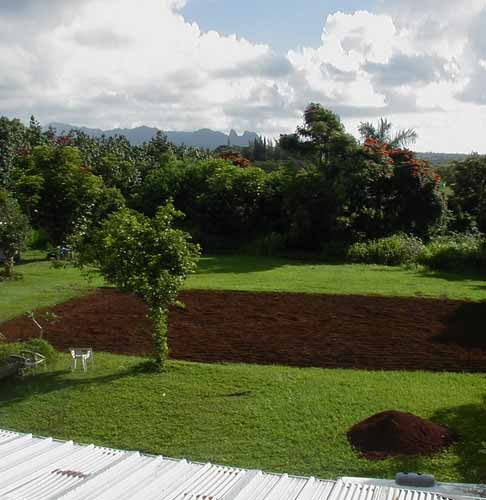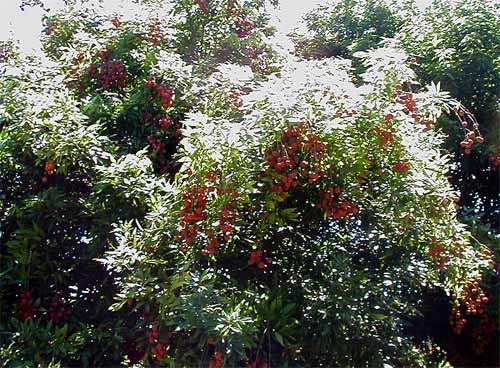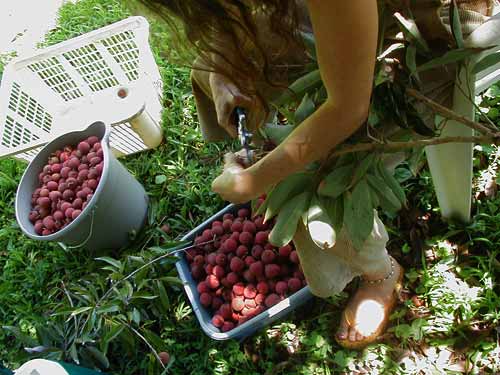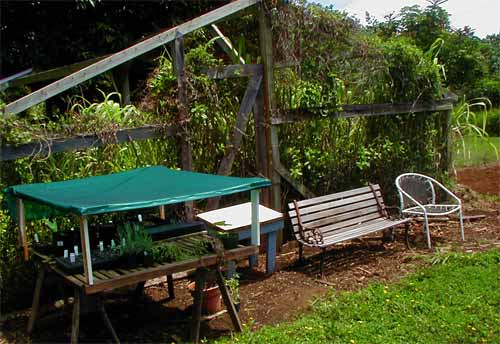June, 2004
Here we are in the very beginning of our transformation of this lovely piece of land. Small steps. We placed putting in a veggie and herb garden at the top of our list. We’d grown used to having an abundance of fresh food right off the land, so we wanted to get that going right away. It’s time and money well spent, considering the price of organic produce, the superior nutritional value of our own produce, and the ways in which our little garden connects us to the community.

We are also beginning the huge task of pruning the lychee trees, nine of them we have, which in a good year will yield hundreds of pounds of the delicious fruit. We will need to figure a few things out to take advantage of that by next year’s harvest.

We are also beginning the huge task of pruning the lychee trees, nine of them we have, which in a good year will yield hundreds of pounds of the delicious fruit. We will need to figure a few things out to take advantage of that by next year’s harvest.

We brought from Kipahulu a bunch of seeds and starts. I built this simple nursery to protect the seedlings and cuttings while they’re getting started. This may be my favorite thing about growing plants: once you have a plant, you can make more by propagating. Some plants are harder than others, but it is a thrill to cut off a piece of a plant and get it growing as a new plant. Equally exciting is saving the seeds produced and growing those. By this process, we are connected to the plants we grew and cared for during our stay in Kipahulu.

I am working on a list of plants we want to get growing on the land. Our goal is to have a very diverse array of food plants, culinary and medicinal herbs, other useful plants and ornamentals.
Established Plants
- Lychee
- Vanilla
- Eggfruit (Sapote)
- Avocado
- Lime
- Meyer Lemon
- Navel Orange
- Tangerine
- Macadamia
- Mango (common)
- Niu (Coconut)
- Surinam Cherry
- ‘Ulu (Breadfruit)
- Noni
- Liliko’i (passion fruit)
- Banana (tall apple)
- Koai’a
- Ti
- Pigeon Pea
- Cardamom
- Strawberry Guava
New Plants
- Lavender
- Mexican Oregano
- Basil (African, Cuban, Genoese)
- Mint (spear, chocolate)
- Kalo (Taro)
- Papaya (waimanalo, )
- Culinary Ginger
- ‘Olena (Turmeric)
- Pineapple
- Grapes
- Chile (Habañero, Jalapeño)
- Katuk (Sauropis)
- Hemp Vitex
- True Yam (Dioscorea)
- Wild Yam
- Madre de Cacao (Gliricidia)
- Okinawan Spinach
- Gardenia
- Galangal (Thai ginger)
Yet To Be Planted
- Lemon Grass
- Bamboo
- Albizzia
- Cacao
- Coffee
- Black Pepper
- Tamarind
- Rollinia (Sapote)
- Avocado (select varieties: spring, summer bearing)
- Tangelo
- Neem
- Banana (Williams, short apple, cuban red)
Cooking and preparing food is a hobby (and sometimes profession) Lisa and I are quite serious about. We will often plan fairly elaborate meals just for the fun of it. Oftentimes we are interested in experimenting with a new ingredient or new way to use a familiar one. When you grow your own food, you of course can’t grow everything you need, but it’s fun and good practice to see how a complete and delicious meal can be prepared with what you have available from the garden. Since we’re very interested in how to eat well, healthily and inexpensively, these informal meals are experiments in developing a personal cuisine that fulfills these ambitions.

